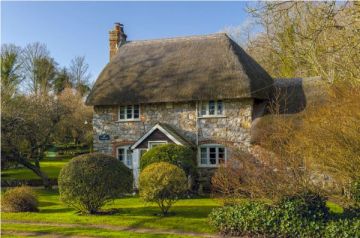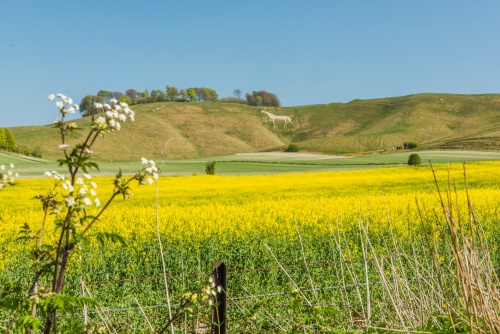
Calstone and Cherhill Downs takes in a breathtakingly beautiful area of Wiltshire chalk downland managed by the National Trust. The Downs form part of the North Wessex Downs Area of Outstanding Natural Beauty. The old coaching road (now the A4) between London and Bristol runs along the northern edge of Cherhill Down. Calstone and Cherhill Downs are also a Site of Special Scientific Interest (SSSI), a recognition of its importance as a chalk grassland habitat for flowers and butterflies.
Rare Butterflies
The chalk downlands of Wiltshire provides a habitat for some of Britain's rarest species of butterflies. Among these species is the Adonis blue, which has two broods during the summer. The first runs from May through early June and the second at the end of summer. From late May into June you will see marsh fritillary, easily spotted by its distinctive chequerboard pattern.
Other frequently spotted species include blue, common, and brown argus. Look for wall browns, which like to bask on the bare chalk. Chalkhill blues can be seen in June. The best places to look for butterflies are sheltered areas in the Calstone Coombes and the southern slope at the western edge of Cherhill Down.
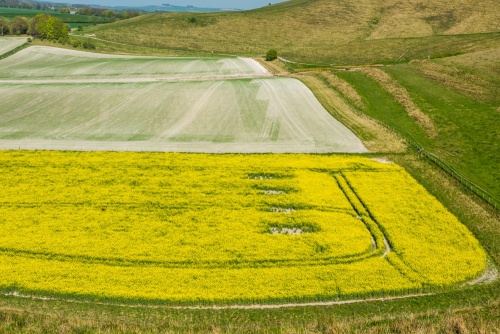
You won't find butterflies without flowers, and the Downs are home to some rare species of chalk downland flowers, among them early purple orchids and the very rare burnt tip orchid. Other orchids such as the common spotted, pyramidal, and butterfly orchids are often seen. The best time for orchids is in late June, while later in summer you will find an abundance of grassland flowers such as knapweed, rampion and field scabious.
Oldbury Castle
Occupying the summit of Cherhill Down is an Iron Age hillfort known as Oldbury Castle. The hillfort partly overlies earlier Bronze Age features. It is defended on three sides by a double earthwork and ditch, and on the other side by a single ditch and bank. There is one entrance in the eastern side, with a parallel arrangement of banks for defence.
The hillfort encloses an area of 22 acres (about 9 hectares). Outside the hillfort are other ancient landscape features including Bronze Age cross dykes and burial mounds. Medieval strip lynchets follow the contours of the hill and medieval pillow mounds for raising hares can be seen.
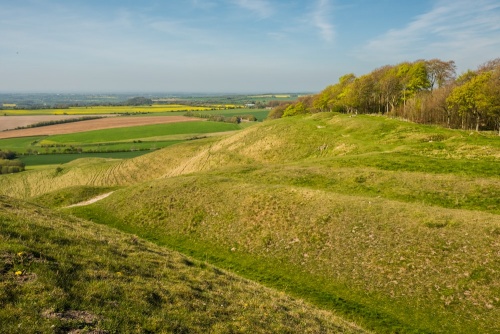
Cherhill White Horse
On the northern slope of Cherhill Down, just below Oldbury Castle, is an 18th-century chalk figure of a horse, known as the Cherhill White Horse. This is the second oldest white horse in Wiltshire, carved in 1780, just two years after the Westbury White Horse.
The horse was created by Dr Christopher Allsop of Calne, who, tradition says, directed the operation fro an observation point at the base of the hill and shouted instructions to his workmen with the help of a large speaking trumpet. Allsop was the family physician to the Lansdowne family of Bowood House and probably modelled his horse after the equine portraits of George Stubbs, a Lansdowne family friend.
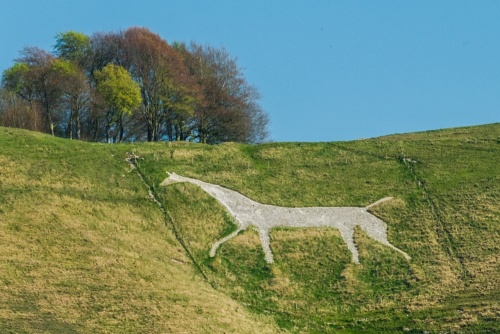
Lansdowne Monument
Within the eastern rampart of Oldbury Castle is the Lansdowne Monument, a striking stone obelisk erected in 1845 by the 3rd Marquis of Lansdowne in honour of his ancestor Sir William Petty. The Marquis had every reason to remember Petty with gratitude, for he built the family fortune in a career that made him the Physician-General to Cromwell's army, the first surveyor of Ireland, a founding member of the Royal Society, a Commissioner of the Royal Navy, and the author of the first book of economic theory base on statistical analysis. The monument stands 125 feet high (38m) and was designed by Sir Charles Barry, more famous for rebuilding the Palace of Westminster in London.
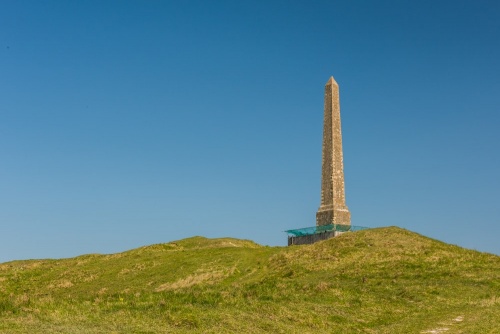
Calstone Coombes
The Cherhill White Horse, Lansdowne Monument and Oldbury Castle are easily accessed from the A4, and get most visitor attention, but there is another feature of the Down that is often missed by visitors. That is the Calstone Coombes, a peaceful area of deep folds in the landscape on the quiet southern part of the Down. It takes only a few minutes to walk from Oldbury Castle to the coombes, but it is well worth the effort.
The network of deep coombes was formed during the last ice age. These quiet valleys are home to a wonderful array of chalk grassland flowers. Here you will see wild orchids in June, and clouds of butterflies such as the adonis blue and marsh fritillary. One resident species in the coombes is the seldom seen wart-biter bush cricket.
Easter Cross
There is one other site of interest on Cherhill Down. Just west of the Lansdowne Monument is a striking cross set upon the summit of a hillock. I was unable to find any information about this cross, which is made of metal and appears to be relatively modern. It has no inscription and isn't mentioned on any of the National Trust information panels for the site. The only reference I was able to find was on a stock photography website where an image of the cross was labelled 'Easter Cross' with no explanation. So that's what I'm calling it here!
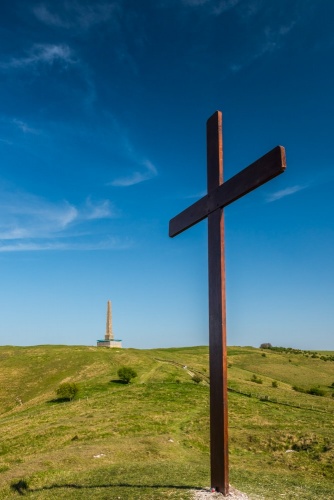
Lansdowne Monument
Getting There
Access is extremely easy, You can reach Calstone Downs from a footpath at the end of the lane that leads to South Farm in Calstone Wellington village, but by far the easiest access is from any of several footpaths that start at the eastern edge of Cherhill village on the A4. There are lay-bys on both sides of the A4 at the edge of the village. There are several information panels and a very obvious footpath leading up the slope of the hill to Cherhill Down.
From there it is very easy to reach Lansdown Monument and Oldbury Castle, while the Cherhill White Horse is just a bit further east along the Down. It will take roughly 10 minutes to walk from Oldbury Castle to Calstone Coombes, following the Wessex Ridgeway from the eastern edge of the hillfort.
About Calstone & Cherhill Downs
Address: A4,
Cherhill,
Wiltshire,
England, SN11 8UY
Attraction Type: Countryside
Location: Access by several footpaths off the A4 at the eastern edge of Cherhill village.
Website: Calstone & Cherhill Downs
National Trust
Location
map
OS: SU045692
Photo Credit: David Ross and Britain Express
HERITAGE
 We've 'tagged' this attraction information to help you find related historic attractions and learn more about major time periods mentioned.
We've 'tagged' this attraction information to help you find related historic attractions and learn more about major time periods mentioned.
Find other attractions tagged with:
NEARBY HISTORIC ATTRACTIONS
Heritage Rated from 1- 5 (low to exceptional) on historic interest
Oldbury Castle Hillfort - 0.2 miles (Prehistoric Site) ![]()
Cherhill White Horse - 0.3 miles (Countryside) ![]()
Lansdowne Monument - 0.6 miles (Historic Building) ![]()
Windmill Hill - 2.8 miles (Prehistoric Site) ![]()
Avebury, St James Church - 3.3 miles (Historic Church) ![]()
Silbury Hill - 3.4 miles (Prehistoric Site) ![]()
Alexander Keillor Museum - 3.4 miles (Museum) ![]()
Avebury Manor and Garden - 3.4 miles (Historic House) ![]()
Nearest Holiday Cottages to Calstone & Cherhill Downs:
More self catering near Calstone & Cherhill Downs



